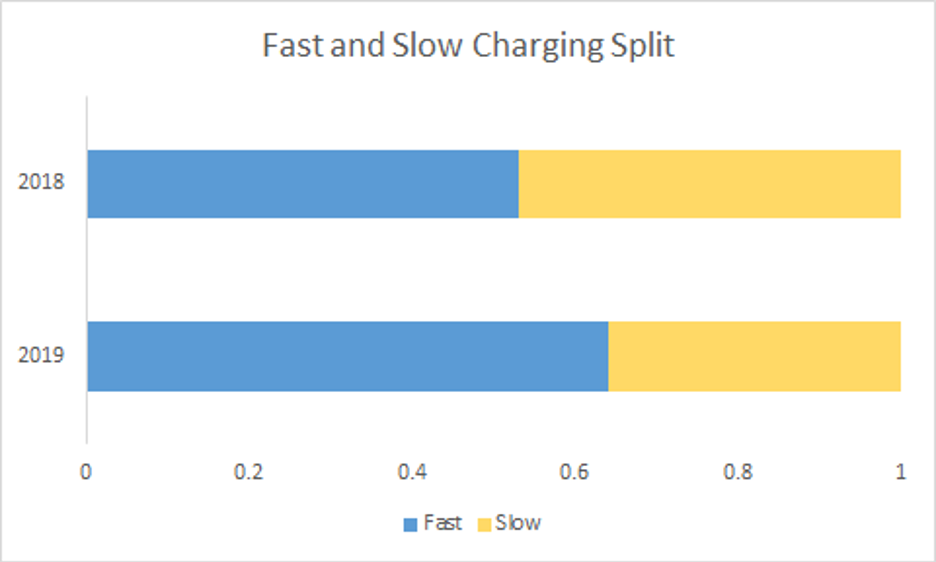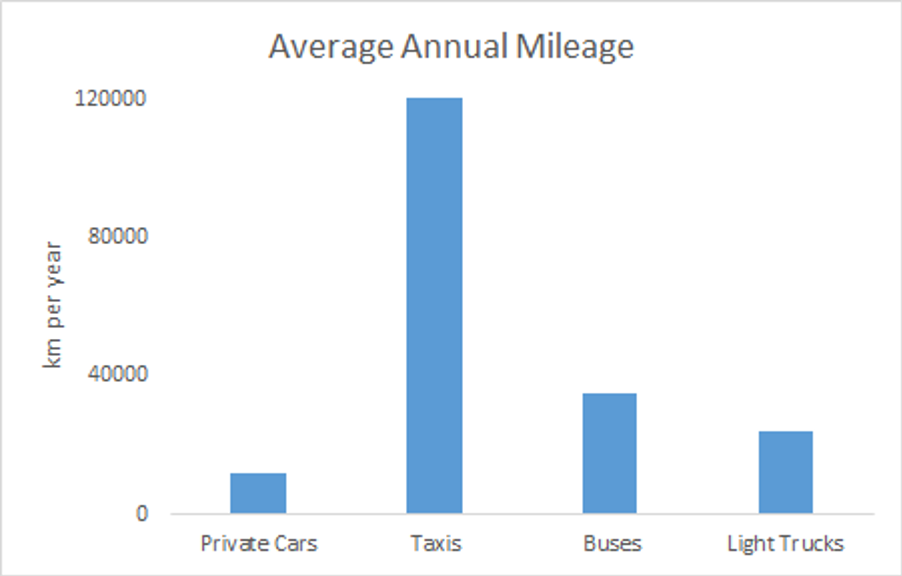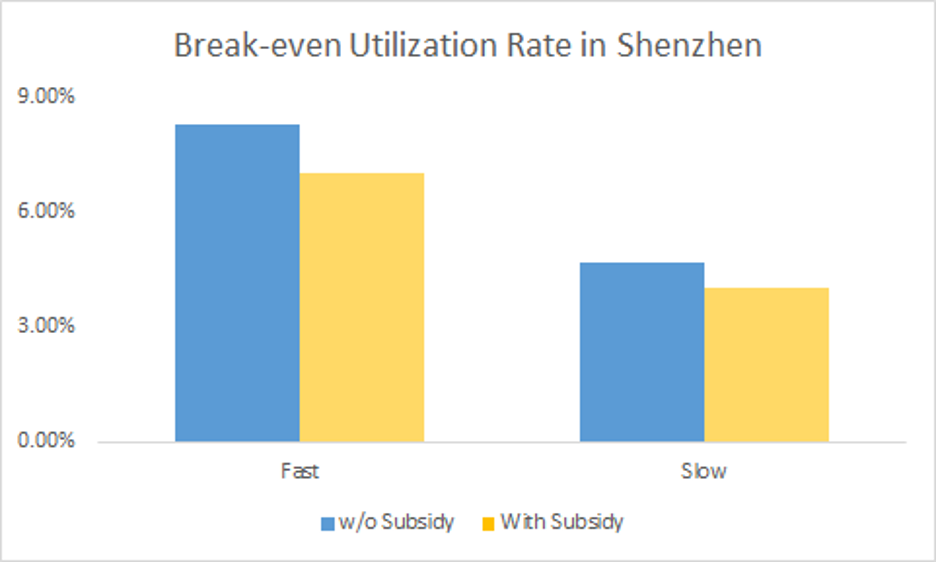Electric vehicle on the parking lot recharging batteries.

China’s Timely Charging Infrastructure Plan
Already the country with the most electric vehicle (EV) charging stations in the world—over 1.2 million in 2019—China is soon looking to add around 600,000 more, thanks to an infrastructure stimulus package announced by the central government in March. The package targets “new infrastructure,” a category that includes information technology, power, and transportation projects and has $1.4 billion earmarked for EV charging infrastructure.
This move comes at a time when many countries, including China, are looking to jump start economic growth and demand to recover from the global pandemic, but also builds on a long history of policies that promote EVs and charging infrastructure. That history of EV promotion is intended to combat the persistent air-quality and carbon-emission problems associated with having the world’s largest automotive market and establish China as a leader in a high-tech automotive industry with high-paying jobs.
The focus on EV charging infrastructure is timely. Two things have historically stood in the way of mass market adoption of EVs: vehicle economics and charging infrastructure availability. However, with steadily decreasing battery costs and a continually growing EV market, many experts in China are seeing charging infrastructure, rather than vehicle economics, as the bottleneck to continued strong growth in EV adoption.
Addressing this bottleneck is vital not only to China, but to any country attempting to build back a cleaner, stronger economy. As RMI has argued in our Global Stimulus Principles report, building back better requires investments that create jobs, support public health, and build more resilient, low-carbon energy systems. If done effectively, developing charging infrastructure can do exactly that, by ushering in cleaner city air, a lower-carbon atmosphere, and paving the way for well-paying jobs in the EV industry.
And as more public and private funds are made available for building EV charging infrastructure in China and around the world, it is vital that this infrastructure be deployed in an effective and efficient manner. This means one that minimizes costs while maximizing benefits for users, cities, and the environment.
In support of these goals, RMI has been focusing on the effective deployment of charging infrastructure in Shenzhen, China, a city with one of the most mature EV markets in the world. This market maturity makes Shenzhen a good case study in effective charger deployment; the obstacles which Shenzhen has faced and the approaches it has taken to overcome those obstacles can inform similar endeavors in the rest of the world.
Below is a short list, informed by our studies in Shenzhen, of key themes that policy makers and infrastructure providers should keep in mind in order to effectively deploy charging infrastructure.
Guidance for Effective Charging Deployment
-
Be user responsive
Many EV charging goals are quoted in magnitudes. California’s goal is to build 250,000 charging stations by 2050, Germany is targeting 1 million by 2030. But these numbers are not the goal in themselves. Installing 250,000 low-power “slow” chargers might meet those thresholds and do it in the lowest cost manner, but if few drivers actually demand slow charging, EV adoption will be no further along than it was before. The real goal is to support vehicle electrification and to do so, charging facilities must be responsive to the diverse charging demands of the drivers they are serving.
For instance, the EV market in Shenzhen is not a monolith: there are electric logistics vehicles (ELVs), buses, taxis, and personal vehicles, each with different charging patterns and needs. Passenger EVs, with long dwell times at home and work, tend to be well-suited for slow charging infrastructure placed in those locations. Electric taxis, on the other hand, usually do not have the ability to install slow charging infrastructure at home or work and seek to maximize driving time during business hours; public fast charging infrastructure is often more consistent with their driving patterns and business needs.
The charging behavior of Shenzhen’s ELVs is an example of how segments of the overall EV fleet require customized infrastructure planning. ELVs in Shenzhen primarily use public fast charging, but they choose to do so close to their home bases. Logistics businesses in Shenzhen are primarily concentrated in three suburban districts—Bao’an, Long Gang and Long Hua—and those are the districts where ELVs primarily charge. Even though charging infrastructure is abundant in central districts—Nan Shan, Fu Tian and Luo Hu—ELVs rarely choose to charge there.
Exhibit 1: Distribution of Infrastructure in Shenzhen
Similarly, ELVs show a distinct preference for high-power fast charging infrastructure. The same analysis shows that from 2018 to 2019, the proportion of fast charging increased by 11 percent (from 53 to 64 percent). Despite the availability of slow charging, the ELV drivers in Shenzhen demanded public fast charging.
Exhibit 2: ELV Fast and Slow Charging Events 2018
Unsurprisingly, this shift to shorter, more convenient charging coincided with a steep drop in complaints of inadequate charging infrastructure from ELV drivers. Moving forward, these trends in demand should be front and center in any decision making about how to serve individual segments within the broader EV market.
-
Maximize charger utilization
Paying attention to the charging needs of different vehicle segments is important to ensure the infrastructure meets the needs of the market. Doing so can help not only the economics of EVs, but also the economics of the infrastructure itself. Charger utilization is a metric to keep in mind to ensure that the chargers being built are economically sustainable. Maximizing the amount that a charger is used throughout the day does two things:
- Spreads the high fixed costs of building chargers over more revenue-generating charging events
- Maximizes the amount of vehicle miles electrified by a given station and thus the benefit to the environment attributable to that station
In China, the equipment itself only accounts for about 1/3 of the total cost of building a new charger station. The rest of the investment is made to secure the land and grid capacity, and on construction works. Breaking even on the high upfront capital costs of construction and siting is no easy feat—to do so, a charging station must sell enough electricity, and thus have enough daily users, to generate that break-even revenue.
On top of that, pricey utility demand charges in some countries can make profitability nearly impossible with low utilization. The only way to do this is to have enough vehicles using the equipment to compensate for the capital costs and demand charges. One way to drive this utilization and create sustainable charging environments is to target high-use vehicles segments and cater infrastructure towards them. Over the course of the past couple years, Shenzhen has done exactly that.
Taxis, buses, and ELVs, such as light trucks and minivans, are the three highest-use vehicle segments in China. With the exception of buses, who need specialized captive infrastructure, these high utilization vehicles predominantly demand public fast charging. This makes them ideal customers to drive utilization at public charging infrastructure and enable a robust charging network to grow in a way that financially sustainable.
Because of superior economics of high utilization EVs and their role in supporting the roll-out of a robust public charging network, those three segments have been the focus of Shenzhen’s electrification efforts. Since 2017, all buses and taxis have been electrified in the city, with electric logistics vehicles fast on their way. This strategy has been instrumental in reducing the public expenditure needed to deploy and operate the public charging network; according to a report by Shenzhen Electric Vehicle Operating Association, the public chargers serving those fleets are obtaining sufficient utilization to be profitable.
Exhibit 3: Mileage Estimates for Different Vehicle Types in China
-
Streamline soft costs
Though the high fixed costs of hardware, software, and grid hosting capability for charging stations can make getting to the black difficult for many charging stations, there is hope. Charging operators are learning to streamline their processes and as a result, those costs are rapidly falling.
However, the less obvious and more obstinate costs of permitting delays, utility interconnection requests, and compliance with a balkanized framework of regulations—all of which fall under the category of “soft” costs—are in more nascent stages of reduction and can make or break a project. Controlling these soft costs is not as straightforward as finding a more efficient design or cheaper material, as they involve complex regulatory frameworks and coordinating communication among a broad array of entities. Designing policies to reduce those barriers and make it easier for operators to install a charger can be an effective lever to promote station profitability.
RMI learned through interviews with stakeholders in Shenzhen that land procurement and grid upgrade requests take months of effort, thousands of dollars and often disincentivize charging operators from undertaking a project. However, the New Infrastructure plan announced in March mentioned that public charging infrastructure projects would receive priority permitting and guarantees of land, energy, and labor. Those policies, if designed well, should go far in pushing costs further down and facilitating a sustainable environment for charging in the future.
-
Provide government support
It’s clear in other areas of vehicle electrification that governments have a role to play in pushing the market to a more self-sufficient state. Zero-emission zones, EV tax credits, and fuel efficiency standards have all helped make EVs a more attractive proposition to manufacturers, consumers, and businesses. In the charging infrastructure market there is also an opportunity for policies that can help the market overcome the initial hurdles that stand in the way of sustainability.
Shenzhen, for example, offers subsidies for construction costs and preferential utility rates which limit the cost of electricity to a charging operator. Both of these combine to allow charging stations to break even faster than they would under normal market conditions. A 60 kW charging station in Shenzhen, which needs to be utilized 8.3 percent of a day to reach profitability under normal conditions, only needs 7.0 percent utilization with these supportive policies. Those few percentage points can be the difference between an environment of low investment and one with large-scale construction.
Exhibit 4: Subsidies Help to Reduce the Utilization Pressure on Chargers
Start with Providing Fast Charging to Fleets
As electrification efforts around the world progress and inevitably run into charging infrastructure bottlenecks, we suggest focusing on fleets as a high-use vehicle segment to kick-start the charging market. Fleets, like buses, logistics vehicles, taxis, and ride-share vehicles, operate much more frequently than personal vehicles. This comes with a number of benefits.
- Charging station profitability: Because of their ability to electrify quickly and at scale, fleets can bring large amounts of demand for charging online quickly—especially for fast charging. This can quickly make expensive public fast charging installations profitable and “crowd in” further investment.
- Environmental benefits: The high usage of fleets relative to passenger vehicles means that one electrified vehicle will bring a larger reduction in air pollution and CO2 emissions in a shorter period of time.
- Vehicle economics: With high daily mileages, electric fleets can take advantage of the lower operating costs of EVs to offset their high upfront costs. Because of this, a highly used fleet will reach parity in total cost of ownership with its internal combustion engine (ICE) counterparts relatively quickly, despite the higher capital cost of EVs. In these cases, cost often is not the barrier to EV adoption; it is the inability to effectively use the vehicle to generate revenue due to long charging times which hinders adoption. Providing sufficient, suitable charging can unlock the business case enabled by lower operating costs and catalyze mass fleet adoption of EVs.
- Build a universal network: While personally-owned EVs typically charge either at the vehicle owner’s home or place of work, many buyers do not feel comfortable buying an EV without the security of a mature public charging network that they can use when needed. An initial focus on fleets can enable the emergence of this public network in a way that is profitable and financially sustainable. This is particularly important in very dense cities or in low income neighborhoods where vehicle owners often do not have access to home-based charging.
In addition, many companies that operate fleets are already looking to electrification regardless of the economic benefits. There are increasing social pressures on companies to be responsible stewards of the environment, and policy pressures, like zero and low emissions zones, that make investments in ICEs risky. However, according to a 2018 UPS report in collaboration with GreenBiz, despite the interest in electrification, only 8 percent of fleet operators surveyed said their company had the infrastructure it needed to support a movement toward electrification.
A Call to Action
The need for serious investment in charging infrastructure has never been more obvious. Public health, specifically the quality of the air we breathe, is emerging as a global priority. The livability of our urban environments is being reassessed. Countries are realizing they need for cleaner, stronger and more resilient economies. Many are waking up to electrified transportation as a tool in furthering all of those goals. As we dive into this new future, we should take with us the learnings we’ve collected along the way to design EV ecosystems in the most effective way we know how.




